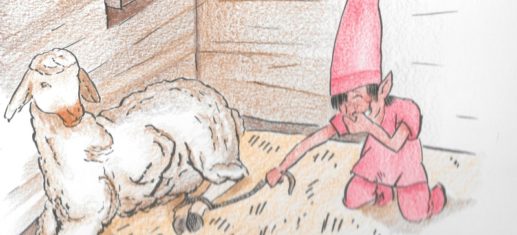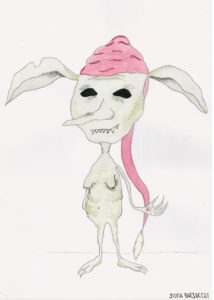The Elf
Buffardello, Baffardello, Pappardello, Linchetto
These are just a few of the names in use in Garfagnana and in the surrounding areas to indicate a spiteful goblin and/or a sudden wind that sweeps up leaves and hay or else collects them neatly in piles.

It was said to be an invisible spirit, or a bird, or a black ball—or else, more frequently, a being wearing a little hat (and even, sometimes, spectacles) who comes from out of the woods, or from somewhere else outside, or who even resides under the eaves of the roof.
Often he took an interest in horses and their manes, or else in cows, which he took to pasture, or fed with hay (or took it away), and he could pay similar attention to donkeys or mules or other animals.
He was particularly feared for playing tricks in the home, and above all when he leant on the chest of those sleeping, taking away their breath.
Women were his favourite victims; he could also try to suffocate infants in their cradles, but fortunately he had holes in his hands.
There were various ways to wear him out or scare him off; he couldn’t bear the colour red, or seeing someone eat while they were using the toilet. A set of scales at the end of the bed stopped him from climbing up onto it, as did the shirt of the man of the house.
At Sant’Anastasio he was known in the form of a spiteful wind, at Borsigliana people told of nightmares. At Vagli di Sotto he sucked milk from the cows; at Magnano he was a small gnome who brought good or bad luck to the cows in the stable; at Capoli he was again a weight that squashed your chest and immobilised you; at Chiozza he was identified with the sudden summer winds, and at Gorfigliano too. At Piazza al Serchio he was identified with a bird or a small being that made piles of leaves; at Pieve San Lorenzo he undid weaving; at Vagli Sotto he made his home in the ears of horses; at Cosina (Piazza al Serchio) he was a black ball; at Albiano he had holes in his hands. …
Umberto Bertolini
Translation by Linda Barwick, The University of Sydney, Australia
Elf’s aspect
How was this being represented? Let’s collect all the accounts in order.
It could be a spirit: “it was a type of sprite that wandered around the village and played tricks” and again “perhaps a small man, a spirit”
It is easy to pass from this idea of a spirit to think of it as a spiteful wind, or perhaps a beneficial one: “it was like a wind, it wasn’t a person”. We find the Buffardello in this guise here and there, almost everywhere.

The idea of an animal was however most widespread: but which one? “it was an animal … like a bird”, “an animal that came at night”, “a white animal, a white bird, Baffardello they called it”, “it was a dark animal, almost like a bird”. Some were quite sure: “The Baffardello was a bird”, “there you could hear this huge bird whistling, and they called it the baffardello”, “a frightening bird, this baffardello”, “it’s a bird that lives at the top of pine trees, sometimes it calls like an owl”, “it was a nocturnal bird”, “it’s a bird that lives mostly up there on the tower”. How big was it? “it was a bird as largeas a duck”, “the baffardello was an ugly bird that came at night”, “it’s a big ugly bird”. But it could be smaller: “like a bat”, or even “the Baffardello is half mouse and half bird”.
Although the animal form of the Baffardello is most widely reported as a bird, nevertheless some other animals should be mentioned: “the Baffardello was a nocturnal animal that didn’t fly, it was an animal like a cat”, “it was an animal, a baffardello that you couldn’t see … it was like a cat”, “it makes a sound like a horse, shorter, it was a type of cat I think”, “they said the baffardello was a kitten or a donkey”.
Sometimes the type of animal was vague: “the Baffardello was a small animal that came at night, then ran away”, “it was hairy to touch”, “the Baffardello really exists, it’s a small black animal this long, with a tail … it looks like a squirrel. Mostly it lives in the stable where the cows are and it likes to live on their tails, it places itself in the tail of the cow and plaits them together”, “it went into the stables, … it’s a black thing, like … a bit different from a squirrel, it has a black tail, all black, and two long whiskers”, “a whole cloud of these animals came, we used to follow them and we’d say ‘The baffardello has come!’”, “it was a person, but it changed itself into a type of billygoat”.
Then there were the anthropomorphic portrayals, certainly the most widespread (along with the wind): “it was a hunchback you could hear at night walking on the terraces … you could hear …. this shuffling footstep, like a lame man”, “he was a man with an iron hat and wooden shoes – I’ve always imagined him as small and ugly”, “the Baffardello? He was a person, a man who disguised himself at night and then went here and there along the streets and they used to say he was the Baffardello… He was a man in disguise, I have always heard him described that way, but…”
But above all “the baffardello is small and dressed like a gnome, because he has that long hat. It doesn’t have a particular colour, it has the colours of nature …. Green. And in fact he camouflages himself when he disappears”, “it was a type of gnome”, “he is a little man who makes plaits everywhere”, “the Baffardello, according to legend, was a little man so high, really small, naughty and spiteful”, “he was a little dwarf: fairly long hair, with a long face and hairy hands with a hole in them […] he wore a beret”. “He had a trident, like a dwarf, like a gnome, with a hood, long feet, a short body and he carried this thing in his hand, yes, a pitchfork with three prongs”, “ and this Baffadello, he was a little man, this small, dressed in red, with a red hat, and he used to go and take the sheep”, “a little man, this small, dressed in red, with a red hat”, “My grandmother told me about the Baffardello, she said he was a little man with short little legs […] who used to sleep under beds”, “he was like a wee small man”, “he was really short, he could fit through the shutters”, “he was a small man, red”, “smaller, with this red pointed hat, which came down to his back”.
There were also nursery rhymes: “The buffardello is a coarse little man / dressed as a gypsy. / He wears a beret on his head / and lives under the roof.”
Some speak of having met him: “he saw a tiny little man, tiny and black, opening the door”, “his face was rather small, pale, with black hair parted in the middle, very black, with two big round eyes staring at her”, “he was a small man dressed in red, like an acrobat”, “he had one green leg, one red, two horns and those eyes”, “he was tiny like a kitten and on his head he had a red hat, made with a point”, “he had phosphorescent eyes, he could only see at night, in the day he couldn’t see”.
Let’s finish with some final images: “a man half a metre tall with holes in his hands”, “he is a fat short little man. He wears a pair of spectacles around his neck and a red beret on his head”, “he had a straw hat above his ears”, “a gnome who had a hat with a sort of pompom on top”.
Etc etc etc.
Umberto Bertolini
Translation by Linda Barwick, The University of Sydney, Australia
Videostories (only in Italian)
Below a list of videostories to read/listen to:
- Il Buffardello a Magnano
- Il Buffardello a Vagli di Sotto
- Il Buffardello a Borsigliana
- Il Buffardello a S.Anastasio loc. Sterpetola
- Il Buffardello a Capoli
- Il Buffardello a Chiozza
- Il Buffardello a Piazza al Serchio
- Il Buffardello a Pieve San Lorenzo
- Linchetto a Vagli
- Il Buffardello a Gorfigliano
- La scusa del Baffardello – Pieve San Lorenzo
- Il Buffardello a Piazza al Serchio 2
- Buffardello a S.Anastasio 7
- Il Buffardello a Cosina di Piazza al Serchio
- Il Buffardello a Giuncugnano
- Il Buffardello a S.Anastasio – 2
- Buffardello non ama il rosso
- Buffardello Cosina 2
- Buffardello a Capannina di Piazza al Serchio
- Buffardello a Capannina di Piazza al Serchio 2
- Baffardello e pecore – Piazza al Serchio
- Baffardello incubo Piazza al Serchio
- Buffardello come dargli noia – Piazza al Serchio
- Buffardello a S.Anastasio 3
- Buffardello a S.Anastasio 4
- Buffardello a S.Anastasio 5
- Buffardello a S.Anastasio 6
- Buffardello: dove sta e come allontanarlo – Giuncugnano
- Buffardello: non si deve mangiare troppo – Guncugnano
- Il Baffardello a Albiano (Minucciano)
- Il Baffardello a Albiano (Minucciano) 2
- Baffardello a Minucciano
- Un Buffardello buono – Piazza al Serchio
- Buffardello dispettoso
- Il Buffardello e Pighettin a Petrognano
- Il Buffardello e l’asina del bisnonno – Borsigliana
- Buffardello e la cavalla di Cogna
- Il Linchetto – Vagli di Sotto
- Baffardello dispettoso – Chiozza
- Il Pollone di Magnano
- Maestaina a Sillicano – Camporgiano
- Il Buffardello a San Donnino
- Ma chi era il Buffardello? Volti trasformazioni …
- Era uno gnomo …
